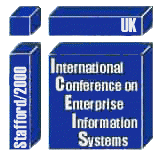 ICEIS 2000
ICEIS 2000
Dr Thomas Greene
Massachusetts Institute of Technology – LCS
A New World for the Enterprise -- E-Commerce and Open Sources
Abstract
The people gathered at this conference are working on very hard problems, but some of the assumptions upon which solutions to these problems are based have radically changed over the past few years, raising questions of who we are designing for and what tools we are using.
Because enabling information technologies are now connecting corporate decision makers directly to information sources at the operations level, traditional pyramid structures are flatter. The internal enterprise information structures have smaller middle management. The change in the external pyramid where consumers were at the bottom of the pyramid has also changed. Now the consumer express opinions and make purchases with a mouse click, not at the end of a direct marketing campaign. For many systems, the success criteria is becoming how many clicks can an enterprise information system generate. In this hour we will examine several issues arising from the new "consumer rules" E-commerce imperative.
Second open source software and vendor standards means that software customers are able to quickly change directions in their system development. For example many information systems that would have been closed by use of a proprietary web server are still kept open to change because they use an open source server as a system foundation. How can Apache be the most widely used server and Linux be a widely used operating system when the basic code is not wrapped up and maintained by a group of companies or a single company? Can global groups of volunteers give away ideas and build systems that out perform thousands of well paid professionals in traditional corporations?
What do the facts of the E-Commerce imperatives and the widespread use of open source programs mean for those of us who must create new systems of information to serve our enterprises?